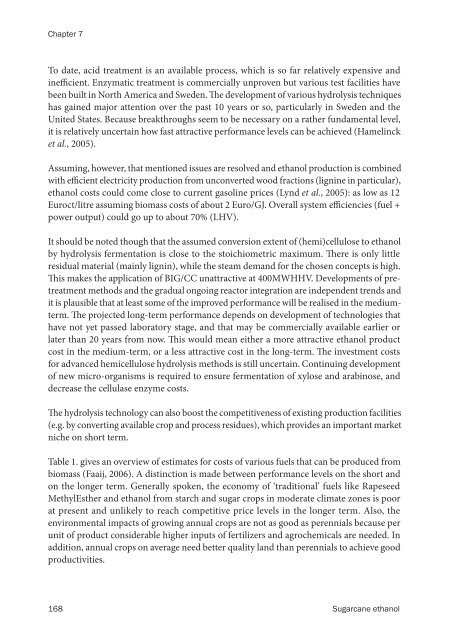Sugarcane ethanol: Contributions to climate change - BAFF
Sugarcane ethanol: Contributions to climate change - BAFF
Sugarcane ethanol: Contributions to climate change - BAFF
You also want an ePaper? Increase the reach of your titles
YUMPU automatically turns print PDFs into web optimized ePapers that Google loves.
Chapter 7<br />
To date, acid treatment is an available process, which is so far relatively expensive and<br />
ine�cient. Enzymatic treatment is commercially unproven but various test facilities have<br />
been built in North America and Sweden. �e development of various hydrolysis techniques<br />
has gained major attention over the past 10 years or so, particularly in Sweden and the<br />
United States. Because breakthroughs seem <strong>to</strong> be necessary on a rather fundamental level,<br />
it is relatively uncertain how fast attractive performance levels can be achieved (Hamelinck<br />
et al., 2005).<br />
Assuming, however, that mentioned issues are resolved and <strong>ethanol</strong> production is combined<br />
with e�cient electricity production from unconverted wood fractions (lignine in particular),<br />
<strong>ethanol</strong> costs could come close <strong>to</strong> current gasoline prices (Lynd et al., 2005): as low as 12<br />
Euroct/litre assuming biomass costs of about 2 Euro/GJ. Overall system e�ciencies (fuel +<br />
power output) could go up <strong>to</strong> about 70% (LHV).<br />
It should be noted though that the assumed conversion extent of (hemi)cellulose <strong>to</strong> <strong>ethanol</strong><br />
by hydrolysis fermentation is close <strong>to</strong> the s<strong>to</strong>ichiometric maximum. �ere is only little<br />
residual material (mainly lignin), while the steam demand for the chosen concepts is high.<br />
�is makes the application of BIG/CC unattractive at 400MWHHV. Developments of pretreatment<br />
methods and the gradual ongoing reac<strong>to</strong>r integration are independent trends and<br />
it is plausible that at least some of the improved performance will be realised in the mediumterm.<br />
�e projected long-term performance depends on development of technologies that<br />
have not yet passed labora<strong>to</strong>ry stage, and that may be commercially available earlier or<br />
later than 20 years from now. �is would mean either a more attractive <strong>ethanol</strong> product<br />
cost in the medium-term, or a less attractive cost in the long-term. �e investment costs<br />
for advanced hemicellulose hydrolysis methods is still uncertain. Continuing development<br />
of new micro-organisms is required <strong>to</strong> ensure fermentation of xylose and arabinose, and<br />
decrease the cellulase enzyme costs.<br />
�e hydrolysis technology can also boost the competitiveness of existing production facilities<br />
(e.g. by converting available crop and process residues), which provides an important market<br />
niche on short term.<br />
Table 1. gives an overview of estimates for costs of various fuels that can be produced from<br />
biomass (Faaij, 2006). A distinction is made between performance levels on the short and<br />
on the longer term. Generally spoken, the economy of ‘traditional’ fuels like Rapeseed<br />
MethylEsther and <strong>ethanol</strong> from starch and sugar crops in moderate <strong>climate</strong> zones is poor<br />
at present and unlikely <strong>to</strong> reach competitive price levels in the longer term. Also, the<br />
environmental impacts of growing annual crops are not as good as perennials because per<br />
unit of product considerable higher inputs of fertilizers and agrochemicals are needed. In<br />
addition, annual crops on average need better quality land than perennials <strong>to</strong> achieve good<br />
productivities.<br />
168 <strong>Sugarcane</strong> <strong>ethanol</strong>












